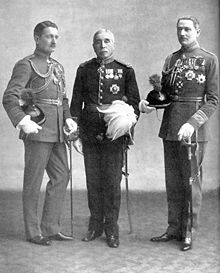Geoffrey Salmond
Sir Geoffrey Salmond | |
|---|---|
Mentioned in Despatches (7) Order of Saint Stanislaus, 3rd Class (Russia) Grand Officer of the Order of the Nile (Egypt) Grand Commander of the Order of the Redeemer (Greece) | |
| Relations | Major General Sir William Salmond (father) Marshal of the Royal Air Force Sir John Salmond (brother) Gwen Salmond (sister) Anne Baker (daughter) |
In 1933, Salmond served as Chief of the Air Staff for only a matter of days before being taken ill and subsequently dying from cancer.
Early life and education
Geoffrey Salmond was born on 19 August 1878 to Major General Sir William Salmond and Emma Mary Salmond (née Hoyle).[1] His siblings included a brother, John,[1] and a sister Gwen.[2] He was educated at Aysgarth School followed by Wellington College in Berkshire before joining the Army.[1]
Royal Artillery service
Salmond joined the
Royal Flying Corps service
Salmond was awarded Royal Aero Club Aviator's Certificate no. 421 on 18 February 1913,[10] and then joined the reserve of the Royal Flying Corps on 17 April 1913.[11] He became a staff office at the War Office on 31 July 1913,[12] a staff officer in the Directorate of Military Aeronautics on 31 August 1913 and then a staff officer at Headquarters Royal Flying Corps in France on 4 August 1914.[13]
Salmond went on to take up the post of Officer Commanding
In July 1916, Salmond was promoted to temporary brigadier general and given command of the RFC in the Middle East.[3] The Distinguished Service Order was conferred on him on 3 March 1917:[17]
for conspicuous ability and devotion to duty when personally directing the work of the Royal Flying Corps during the action. The striking success attained was largely due to his magnificent personal example.
The action referred to was during the operations in Sinai at the end of 1916.[1] In this command he was responsible for providing air cooperation for General Jan Smuts's force in East Africa,[5] for the forces in Salonika and Mesopotamia, for Allenby's conquest of Palestine, and for the RFC in India.[5] He was promoted to the substantive rank of lieutenant colonel on 3 September 1918.[18]
While holding the command of the Middle East, he had laid out an airway from Cairo to South Africa,
Royal Air Force service

Salmond was awarded a permanent commission in the Royal Air Force as a
Salmond's next appointment was as
On 1 April 1933, Air Chief Marshal Salmond took over from his brother John as Chief of the Air Staff.[30][31] Salmond had become severely unwell and days later (5 April) arrangements were announced for Sir John Salmond to resume the RAF's senior post temporarily.[32]
Family
In 1910 he married Margaret Carr, daughter of
Death
Salmond died on 27 April 1933 and Sir John carried on his duties as Chief of the Air Staff for several more weeks afterwards.[3] Salmond had a large funeral procession with Trenchard as one of the pallbearers.[34]
Publications
- Salmond, Sir Geoffrey (1929). Report on the Air Operations in Afghanistan Between December 12th, 1928, and February 25th, 1929. London: Her Majesty's Stationery Office.
References
- ^ required.)
- ^ Obituary Mary H. Hoyle Salmond.. Retrieved 20 August 2014.
- ^ a b c d e f g h i j k "Air Chief Marshal Sir Geoffrey Salmond". Air of Authority – A History of RAF Organisation. Retrieved 5 August 2012.
- ^ "No. 26983". The London Gazette. 1 July 1898. p. 3985.
- ^ a b c d e f "Obituary: Sir Geoffrey Salmond Air Chief Marshal And Chief of the Air Staff". The Times. London. 28 April 1933. p. 19. Retrieved 5 August 2012.
- ^ "No. 27248". The London Gazette. 20 November 1900. p. 7137.
- ^ "No. 27798". The London Gazette. 26 May 1905. p. 3769.
- ^ "No. 27875". The London Gazette. 16 January 1906. p. 383.
- ^ "No. 28111". The London Gazette. 21 February 1908. p. 1206.
- ^ "Aviators' Certificates". Flight International. 1913. Retrieved 5 August 2012.
- ^ "No. 28720". The London Gazette. 20 May 1913. p. 3592.
- ^ "No. 28747". The London Gazette. 19 August 1913. p. 5932.
- ^ "No. 28879". The London Gazette. 25 August 1914. p. 6686.
- ^ "No. 29055". The London Gazette. 2 February 1915. p. 1018.
- ^ "No. 29276". The London Gazette. 24 August 1915. p. 8520.
- ^ "No. 29608". The London Gazette (Supplement). 2 June 1916. p. 5565.
- ^ "No. 29968". The London Gazette (Supplement). 2 March 1917. p. 2190.
- ^ "No. 31160". The London Gazette (Supplement). 31 January 1919. p. 1760.
- ISBN 978-1-78155-370-1.
- ^ "No. 31002". The London Gazette (Supplement). 8 November 1918. p. 13274.
- ^ "No. 31098". The London Gazette (Supplement). 31 December 1918. p. 91.
- ^ "No. 31273". The London Gazette (Supplement). 4 April 1919. p. 4513.
- ^ "No. 31498". The London Gazette (Supplement). 8 August 1919. p. 10195.
- ^ "No. 31486". The London Gazette. 1 August 1919. p. 9864.
- ^ "No. 32635". The London Gazette. 10 March 1922. p. 2048.
- ISBN 978-3-030-60554-4.
- ISSN 1463-6298.
- ^ "No. 33513". The London Gazette. 2 July 1929. p. 4365.
- ^ "No. 33898". The London Gazette (Supplement). 30 December 1932. p. 16.
- ^ "No. 33926". The London Gazette. 31 March 1933. p. 2194.
- ^ "Sir Geoffrey Salmond ill". Aberdeen Press and Journal. 3 April 1933. p. 6 – via British Newspaper Archive.
- ^ "Sir Geoffrey Salmond". Yorkshire Post and Leeds Intelligencer. 28 April 1933. p. 11 – via British Newspaper Archive.
- ^ "Happy 100th for Anne", Salisbury Journal, 21 May 2014. Retrieved 10 August 2014
- ^ "Air Staff Chief's funeral". The Scotsman. 2 May 1933. p. 12 – via British Newspaper Archive.
Further reading
- ISBN 0-85052-980-8.
- ISBN 0-11-772635-4.

